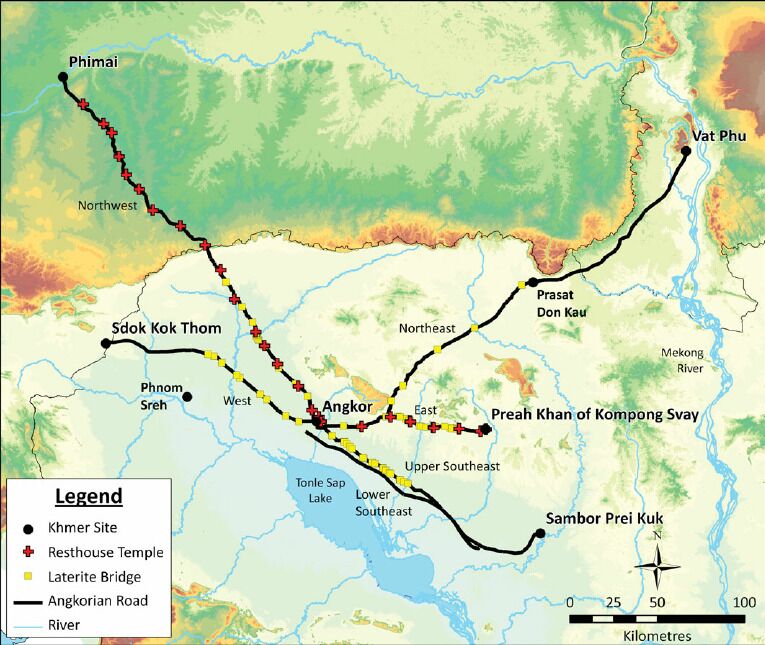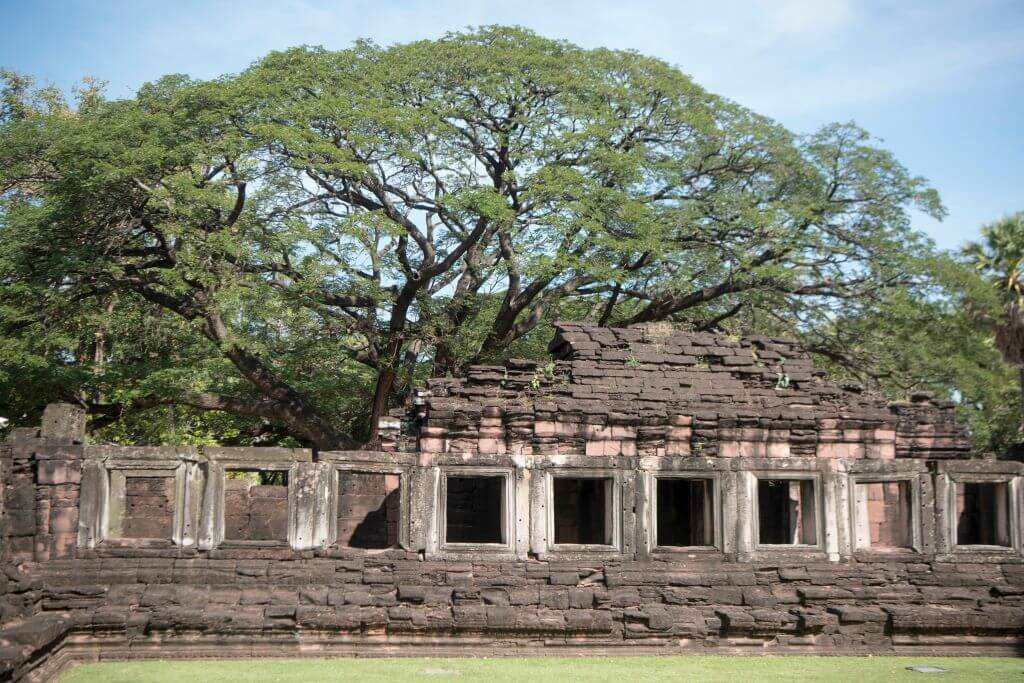The Phimai Historical Park is all the reason you need to seek out the lovely Thai town of Phimai in Nakhon Ratchasima Province in northeast Thailand. From 1000 AD, Phimai was an important outpost of the Khmer Empire and remained that way for 300 years. Today the quiet town is known for the wonderful Khmer ruins, for being the birthplace of the Korat breed of cat, and for the Sai Ngam, the largest banyan tree in Thailand.
Phimai was once part of the Khmer Empire
A quick dip into a history encyclopaedia brings up the name of Angkor Wat as the capital of the Khmer Empire during the time of the Khmer kings.

Sometimes dubbed the eighth wonder of the world, Angkor Wat, along with important temples such as Phnom Bakheng, Preah Kham, and Angkor Thom, records the heights of Khmer architecture first as Hindu, then Mahayana, and then finally as sites of worship for Theravada Buddhism.
The ancient history of these sites begins with King Jayavarman II and ends with the reign of King Jayavarman VIII.
During this period the Khmer Empire spread from the banks of the Tonle Sap River and at its peak covered much of what is known today as southern Vietnam, Laos, Cambodia, and Thailand.

Most tourists will visit Bangkok and the ancient ruins of Sukhothai and Ayutthaya but many will miss one of the most interesting of all: Phimai in the Isan region of northeast Thailand.
How to get to Phimai Town
Phimai can be reached from Bangkok by catching a bus to Nakhonratchasima (Khorat) bus terminal. You can take either a train or bus to Phimai as they both take around 4 hours.

The bus will head to Bogoso Mai where you will catch another local bus directly to Phimai. You can also take a guided tour which will run from Bangkok and offer hotel pick up or hire a car.
The drive to Phimai town takes an hour. There is a small parking lot but also free street parking.
Where to Stay in Phimai: Our Top 3 Picks
A half-day in Phimai Historical Park and then a trip to the Phimai National Museum is best done as an overnight trip from Bangkok.
Phimai does not have many chain hotels, but it does have a few modern ones and charming local guesthouse accommodations on the river. Here are the best three:
Top 3 Phimai Stays
🎆 Phimai Paradise Boutique Hotel: 8.2/10 (149 reviews) – Our top pick is only 250 meters from Phimai Historical Park. This 4-star hotel has large modern and well-decorated rooms and a free airport shuttle and wifi.
Book It🎆 Amatara Hotel: 7.5/10 (49 reviews) – this 4-star Amatara Hotel has lovely clean rooms with river views, a great terrace, and free bikes to ride the 700 metres to the Phimai Historical Park!
Book It🎆 Baan Lita: 9.2/10 (45 reviews) -by far the cleanest hotel you will ever find in Thailand! A lovely cafe/beer garden, and has extremely high reviews with an average of 9.2 out of 10. A great budget option.
Book ItThe Royal Road from Angkor Wat to Phimai
Phimai is a Khmer temple that dates back to the 11th century. King Jayavarman VII was the last great ruler, and he replaced Hinduism with Mahayana Buddhism as the official religion of the Khmer.
Phimai was critically important to his Khmer empire and because of its importance, was connected to Angkor Wat (225 kilometres southeast) by a long highway known as the “Royal Road.”

Anthropologist Mitch Hendrickson* created this fantastic map (above) of the Ancient Khmer road system extending to Phimai.
The highway, like other routes that joined the Khmer Buddhist world into a coherent spiritual landscape, was made into a sacred space through the planting of Banyan trees along the route (Skidmore 1996)* and the placing of religious statues along bridges and other Khmer temples between Angkor Wat and Phimai.
Religious Origins of Phimai
Prasat Hin Phimai is extremely well-preserved and most historians believe that it was a Buddhist temple built by Hindu workers.
It was most likely built during the 11th century by Suryavarman who was King of the Khmer Empire from 1010 until 1050.

The religious origins of Phimai are still in debate today.
Evidence within the site suggests that Phimai was an important Buddhist spiritual site, but archaeological evidence points to other practices, including Hindu, Animism, and varying Buddhist practices that predated Theravada Buddhism at Phimai, just as it did at Angkor Wat in Cambodia.
The deity worshipped at Phimai was the Mahayana Buddha, Adi Buddha, who is sheltered by a naga, or a 7-headed snake, called Muchalinda.

Certainly, the location of the site had something to do with its defensive geography. Phimai is surrounded on three sides by the Mun River.
Prasats and the Layout of Phimai Historical Park
When visiting Phimai from the town of Khorat to the south of the site, a river must be crossed and you enter into an ancient space which according to archaeologists was the bathing place of the local heroine Thao Suranari.
Known as Ya Mo she is a Thai heroine who led the battle to overthrow the Lao warriors who had invaded the country.
If you visit Khorat you can see a sculpture and memorial to Ya Mo in the centre of town.

Phimai was restored and opened to the public with the help of the same experts who worked at Angkor Wat in Cambodia.
Historians believe that it is possible that Phimai might have been the model for Angkor Wat, which was built in the century following Phimai’s construction.
Phimai comprises three rectangular enclosures called prasats, and each enclosure’s outer wall is actually the outer wall of the greater city site.
It is a wonderful state of restoration compared to the many structures in Angkor Wat that are being covered by the jungle.
Khmer temples were built to represent the universe and the main tower within a temple complex is said to represent Mount Meru which is the holy mountain of Hinduism and the centre of the Hindu universe.
Within the temple that represented Mount Meru, a Hindu sacred linga could be found.
But although the central prang at this UNESCO World Heritage Site references Hindu cosmology, there are Buddhist inscriptions inside the temple, showing that Phimai was designed to be a Buddhist site.
This tower predates Angkor by several years and it is thought that it was the model for Angkor’s great towers.
Prasat Hin Phimai
The official name of the temple is ‘Prasat Hin Phimai’ which is located within the Phimai Historical Park. An adult entrance ticket costs 100 Thai Baht.
If you wish to see the Phimai National Museum – see below- that is an additional 50 Baht and is well worth the money.

Phimai is the largest Khmer temple in Thailand, and the complex measures over 1,000 meters long by almost 600 meters wide.
The complex is entered over a decorative Naga bridge. It has naga (serpents) and singha (guardian lions) on either side.
The bridge symbolizes the pathway from the human realm to the place of the gods.
Archaeologists believe that the bridge is similar to the Angkor Wat style of architecture which would indicate that it was added in or around the 12th century.
Phimai, unlike most Khmer temples, faces south east. Historians think this is because it is oriented towards Angkor Wat as its cardinal direction.

Once over the bridge, the walk takes you through open space before you come to the enclosure at the center of the temple.
Within this enclosure sits a temple complex made up of three Khmer prasats or temple structures. The main tower, the Brahmadat, and the Redstone tower.
The main tower has a gopura or entrance similar to those found at Angkor Wat and other temples from the 12th century.
This tower has some beautiful images carved into it including scenes of Hindu deities and the legends around them. The interior of the tower has an array of Buddhist carvings.
Prang Brahmathat
It is believed to have been built prior to the central sanctuary, as it is made of laterite (a type of red rock) rather than sandstone which was used in many of the other buildings.

Within the Prasat is a statue of Khmer King Jayavarman VII, which was discovered within the structure.
Prang Hin Daeng
Nicknamed the Red Stone temple because it is made from pink sandstone.

It is believed to have been built in the 13th century, making it one of the youngest, but it is also the most crumbling ruin at Phimai.
Statues carved into the stones include a meditating Buddha and sculptures of demons and animals range around the walls.
There is a small gallery around a courtyard with inscriptions dedicated to Buddha that have been dated to before Angkor Wat was built.

Phimai is an underappreciated ancient Khmer temple of great significance to the Khmer Empire in Southeast Asia.
The advantage to that is that, unlike Angkor Wat in Cambodia, there are many fewer tourists visiting this beautiful site.
Phimai Museum
The Phimai National Museum is a highlight of any visit to Phimai.
Only 300 meters from the entrance to the Phimai Historical Park, this three-story museum puts it all together in terms of understanding the empty Khmer ruins.

It is hard to see something still standing from a turbulent period of ancient history – the 11th century in Southeast Asia and imagine what this busy site must have been like.
The museum will help you visualise the rooms and galleries at Phimai.
Of the three zones of the museum, the downstairs area displays perhaps the very best collection of Khmer artifacts found in Phimai and in northeast Thailand.
You can see the statue of King Jayavarman VII, pediments, and wonderfully sculpted lintels taken from the site, and gold and silver items found there.
The museum is open from 9 am to 4 pm Wednesday to Sunday.
Further Resources
*Hendrickson, Mitch. (2010). Historic routes to Angkor: Development of the Khmer road system (ninth to thirteenth centuries AD) in mainland Southeast Asia. Antiquity. 84. 480-496).
**Skidmore, Monique. “In the Shade of the Bodhi Tree: Dhammayietra and the Re-Awakening of Community in Cambodia.” Crossroads: An Interdisciplinary Journal of Southeast Asian Studies 10, no. 1 (1996): 1–32. http://www.jstor.org/stable/40860548.

